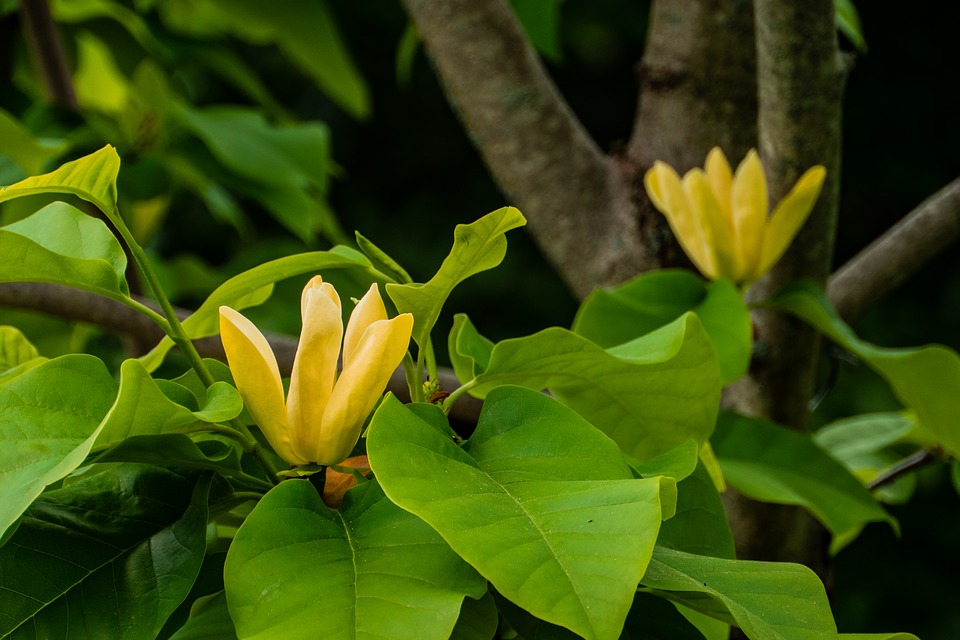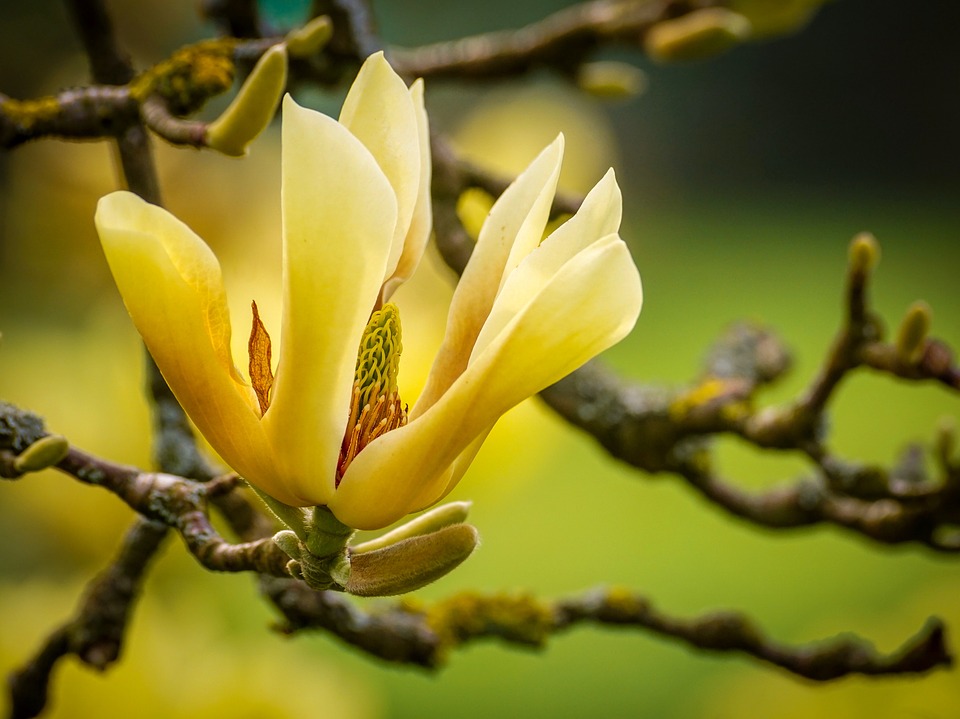
Magnolia acuminata, commonly known as cucumber tree, is an ideal ornamental plant for shading vast sunny gardens.

General characteristics of the yellow Magnolia – Magnolia acuminata
There Yellow magnolia, botanical name Magnolia acuminata, is a deciduous plant of the Magnoliaceae family native to North America where it is widely diffused in the rustic state in the cool and humid places of the mountains up to 1500 meters above sea level.
It is a fast growing plant that averages 10 meters tall. It has a strong and deep root; erect trunk with thin light gray bark; pyramidal or columnar crown that becomes rounded with age.

The leaves of the yellow Magnolia, they are about 18 cm long; they have an oval shape, a leathery and waxy consistency, a bright yellow-green color that turns golden yellow in autumn. The leaf plate is glabrous, with an entire margin and sharp apex.
Read also: Doronico yellow daisy Doronicum
THE flowers they are similar to yellow tulips that persist on the branches for 2 to 4 days and close at night. Pollination is entomogamous, it occurs by insects.

THE fruits they are green cucumber-shaped cones that turn bright red when ripe. At the end of the summer the mature, hairy fruits or follicets open, releasing the orange-red seeds that hang on thin threads before falling to the ground.
THE seeds, 10 to 60 seeds per fruit, have a double coating: a fleshy, oily and soft outer coat and a hard, thin and membranous inner coat enclosing a large and fleshy endosperm.

Flowering
Magnolia acuminata blooms in spring, between April and May.
Cultivation of yellow Magnolia – Magnolia acuminata
Exposure
The yellow Magnolia plant should be grown in a sunny place in areas with a cold and continental climate, in partial shade in those where summer temperatures are very high. It does not tolerate strong winds and survives the harsh temperatures of the winter months.
Ground
Even if the magnolia acuminata grows well in any soil, even calcareous or stony, it should preferably be cultivated in the soft and humus-rich one, with a preferably acid pH mixed with a good amount of peat and above all well drained. In compact and poorly draining soil, the yellow Magnolia suffers from water stagnation and gets sick from root rot.
You may be interested in: Evergreen Magnolia Grandiflora
Watering
Even if the adult Magnolia is satisfied with the rains, it should still be irrigated during periods of prolonged drought and during the summer months. The young and recently planted specimen, on the other hand, should be irrigated regularly, always waiting for the soil to dry well between one watering and the next. In autumn and winter, watering must be suspended.
Fertilization
To grow, develop and produce flowers in abundance, it needs a soil rich in nutrients, therefore at the end of winter bury mature manure or slow-release granular fertilizer at the foot of the plant. From the vegetative restart onwards, once a month, a fertilizer rich in nitrogen and potassium, diluted in the irrigation water.
Yellow magnolia: cultivation in pots
This species of Magnolia can also be grown on the balcony or terrace of the house using a wider and deeper pot than the earthen bread that surrounds its root.
To facilitate the drainage of water from irrigation, a layer of expanded clay is placed on the bottom of the pot, covered with a layer of a mixture of universal soil mixed with peat and mature manure.
Place the plant in the center of the pot, add more soil up to the height of the collar, compacting it well and taking care not to leave air gaps.
The pot is moved to a sunny and sheltered area from the wind and then watered abundantly.
Subsequently, the water supplies must be regular during the flowering period and in the summer months, but without excess.
Every year, fertilizer for flowering plants must be added, preferably in autumn, and chelated iron to combat excess limescale.
Repotting the magnolia
It is a species that does not like transfers therefore repotting should be avoided in order not to risk traumatizing it. Generally 3 cm of soil is removed and replaced with the same amount.

Multiplication of the yellow Magnolia – Magnolia acuminata
The yellow Magnolia like the many ornamental magnolias other species reproduces by seed at the beginning of autumn or by vegetative way, in the nurseries, new specimens identical to the original plant are obtained by semi-woody cutting in summer.
Sowing
For sowing, mature seeds collected from plants are used. The seeds must first be scarified and then cold stratified for 3-6 months in a seedbed containing loose and fertile soil, kept just humid until the buds appear. After about 1 year, when the seedlings are robust and easy to handle, they are replayed in single pots and grown in them until the moment of final planting, not earlier than 3-4 years. Plants born from seed will produce their first blooms after 12 or more years.
Propagation by cuttings
In summer, cuttings at least 10 cm long are taken from the main healthy and vigorous branches and rooted in a mixture of sand and peat in equal parts. Once rooting has taken place, the new seedlings must be repocked in individual containers and reared in them for at least 2 years before being planted in the ground.
Yellow magnolia plant
The yellow Magnolia is planted in the ground or in pots between March and April, in holes twice the size of the root system. Young plants must be guided in the first years of growth by special tutors.
Pruning
It is a plant that does not tolerate drastic pruning so we only intervene to give harmony of shape to the foliage by cutting dry or damaged branches and shortening the disordered ones. Pruning should be done after flowering, between the end of summer and the beginning of autumn, or just before the vegetative restart of the plant, at the end of winter, using well-sharpened and disinfected shears.
Pests and diseases of the yellow magnolia
The yellow magnolia fears the attack of aphids and scale insects. Among the fungal diseases it is subject to gray mold and root rot caused by excessive watering and water stagnation in the saucer.
Cures and treatments
The root system of Magnolia acuminata, like Magnolia grandiflora, fears frost and therefore requires winter protection with a mulch of straw or dry leaves.
Pest infestations must be contrasted with specific broad spectrum products or by introducing antagonistic insects especially greedy of aphids into the environment. Phytosanitary treatments must be applied in February, when the flowers are still in bloom.

Hybrid varieties of yellow Magnolia
On the market, in addition to the rustic botanical species, there are many hybrid species also with foliage appreciated in gardening for their greater resistance to adversity, adaptability to the climatic conditions of our regions and all with the same cultivation needs.
Magnolia Elizabeth
A very vigorous hybrid species about 10 meters tall, with pyramidal crown, green leaves and large creamy yellow cupped flowers, which bloom in spring in early May, before the leaves. Flowering lasts 3 weeks. This hybrid, created in 1956 in the Brooklyn Botanic Garden in New York, bears the name of Elizabeth Scholz, the director of the garden.
Magnolia x brooklynensis Yellow Bird
A slow growing hybrid species, about 8 meters high, obtained by crossing the Magnolia acuminata and the Magnolia lilliflora. It has a strictly conical, almost columnar crown with obovate deciduous leaves, quite large, slightly shiny, green in color from spring to autumn when they turn yellow for a short period of time and fall off early. From the end of May and for 2-3 weeks it produces numerous cupped flowers of an intense yellow color with green reflections on the outside that appear at the same time as the leaves. It is suitable for growing in many types of well-drained soil without water stagnation. It needs organic fertilizations especially in autumn and cupric treatments during the year.
Magnolia x brooklynensis Hattie Cartan
It is a hybrid plant with a pyramidal crown. It has large green leaves that develop after flowering. In spring it produces tulip-like flowers with yellow petals. The flowers are pink soft yellow tulips.
Magnolia Gold Star
Hybrid species obtained from the cross between Magnolia acuminata and Magnolia stellata. It is a deciduous shrub about 3 meters high. Before the appearance of the leaves, between March-April, it produces delicately scented, light yellow flowers in the shape of a star. It is very rustic, does not require special attention and is suitable for small spaces.
Magnolia Yellow Lantern
A conical shrub species, 150 cm high. it has green deciduous leaves and in spring, between April-May, it produces numerous straw-yellow tulip-shaped flowers. Flowering occurs before leaves are formed. Likes acidic, peat-mixed, well-drained, humus-rich soil. It is also suitable for growing in pots and withstands temperatures of -10 ° C.
Magnolia Yellow River
It is a deciduous shrub native to Holland that reaches a height and a width of about 3 m. It has large, dark green ovate leaves that appear after flowering. The flowers, about 10 cm long, are cream-yellow cups, paler internally. It blooms in March-April, on leafless branches ….



Add comment